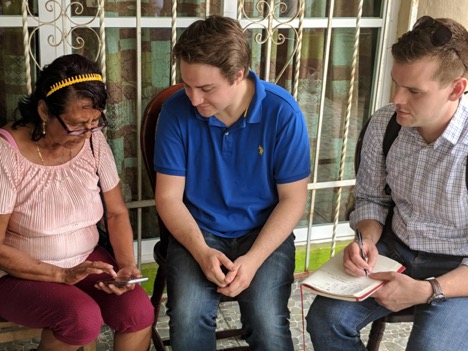Character Counts
Innovative Scoring Tool Uses Behavioral Cues to Assess Credit Risk
Editor’s Note: Entrepreneurial Finance Lab (now LenddoEFL) first pioneered psychometric credit scoring through research at the Harvard Center for International Development in 2006. The project aims to stimulate entrepreneurial finance in emerging markets by developing low-cost credit screening tools that address the information asymmetry which commonly prohibits unbanked SMEs from accessing financing that could help them grow their businesses. To date, EFL’s partners have lent over $1.5 billion USD using EFL’s assessment. SCN discussed the innovative program with Jonathan Winkle, Behavioral Science Manager at LenddoEFL.
SCN: Limited presence of formal banking and a lack of established credit has made access to financing a significant barrier to growth for small businesses in emerging markets. What made LenddoEFL believe that a borrower’s personality could be a reliable indicator of his/her “creditworthiness?”
 JW: The initial inspiration came from reading a number of papers examining successful entrepreneurs and how they are different from non-entrepreneurs (e.g. managers) or unsuccessful entrepreneurs. These papers used psychometric instruments to examine individual differences and found some consistent differences that we thought could be leveraged for credit risk. We also came across the pre-employment screening industry and their use of psychometrics to select among job applicants. If you think of running a small business as simply another type of job, then psychometric predictors of success could be found for that job just as they have been found for other employment categories like accountant, engineer, or customer service representative.
JW: The initial inspiration came from reading a number of papers examining successful entrepreneurs and how they are different from non-entrepreneurs (e.g. managers) or unsuccessful entrepreneurs. These papers used psychometric instruments to examine individual differences and found some consistent differences that we thought could be leveraged for credit risk. We also came across the pre-employment screening industry and their use of psychometrics to select among job applicants. If you think of running a small business as simply another type of job, then psychometric predictors of success could be found for that job just as they have been found for other employment categories like accountant, engineer, or customer service representative.
SCN: Are there any examples of specific behavioral types that would more likely indicate that an Individual is a higher or lower credit risk?
JW: One interesting behavior related to credit risk is overconfidence. While we might expect that high confidence could help a person overcome the challenges of managing and repaying a loan, it turns out that there can be too much of a good thing. An overconfident person might be a risky borrower because they firmly believe they will repay a loan despite lacking the skills necessary to achieve this goal, and they may not plan and prepare adequately for downside scenarios. In our assessment people complete a variety of games that measure personality traits and we compare their perceived performance to their actual performance to get a measure of overconfidence.
An example of a behavior linked to lower credit risk is conscientiousness. Conscientiousness is one of the Big 5 personality traits that has been heavily studied, and a person high on this trait is organized, dependable, has good self-control, and plans out tasks thoughtfully. In contrast, someone with low conscientiousness is unreliable, sloppy in their work, and prone to spontaneity rather than planning. Given the skills required to run a business and manage lines of credit, it’s easy to see why a highly conscientious person has a low credit risk profile. Rather than trying to determine one metric for conscientiousness, our assessment has multiple exercises that measure the different facets of conscientiousness. This allows us greater fidelity in our understanding of a person’s conscientiousness, and therefore greater precision in using this metric to assess creditworthiness.
SCN: Do potential “lendees” know that the questions they are responding to are meant to determine their creditworthiness? How do you prevent individuals from trying to “beat the system?”
JW: Yes, applicants are fully aware that their responses will be used to determine whether they receive credit or not, and therefore preventing them from beating the system is extremely important. To prevent cheating, we developed a set of algorithms that identify anomalies in applicant behavior as they take our assessment. These algorithms analyze how someone answers questions (e.g., the time it takes to complete an exercise), rather than what their answers are to avoid those favorable pictures you mentioned.
Another “beat the system” concern actually comes from the loan officers who sometimes help deliver the assessment to applicants. Loan officers’ commissions are in part based on the volume of approved applicants they bring in, and therefore may help applicants cheat and get approved to increase their own commissions. Our algorithms look for similarity in answers across applicants that have been screened by the same loan officer to determine whether that employee is feeding the applicants answers.
But at the end of the day, we actually want applicants to try and beat the system and paint a favorable picture of themselves. It works the same way in the world of psychometrics for pre-employment screening. Everyone tries to present a favorable picture of themselves, and the models aren’t based on some hypothetical fully honest set of answers. Instead, the predictors that make it into the model are based on how defaulters try to beat the system in a different way from good repayers.

Jonathan Winkle (far right) doing field research in Mexico to create new psychometric credit assessment content
SCN: Can you provide specific examples of how AI/machine learning has helped to hone the assessment process/make it more reliable?
JW: One of the biggest challenges we face is creating assessments and predictive models that bridge immense differences in cultures, customs, and norms across the globe. For example, a trait like optimism might be highly predictive of creditworthiness for a 70-year-old appliance store owner in urban India, but not for a 30-year-old rural Guatemalan farmer. The large amount of data we have from borrowers from around the world is an incredibly valuable asset, yet, given these considerable data stores, we cannot identify cross-cultural similarities efficiently using human-powered analyses. Machine learning algorithms are simply better and faster at combing these large datasets for the insights that allow us to hone our assessments and ensure high accuracy when determining creditworthiness.
SCN: While this approach has evolved to enable more inclusivity in supply chain finance, do you see that it might also be used in the future with established finance relationships to further reduce default risk?
JW: Improving traditional credit scoring mechanisms with alternative data is certainly possible, however it is not the focus of our company. We are first and foremost committed to helping the billions of people around the world who lack access to financial services. However, as time goes on and alternative credit scoring becomes more commonplace, its predictive value will be hard to ignore and we will likely see it being incorporated into established finance relationships.
SCN: As you continue to build the foundation for psychometric credit rating, where do you see this technology going next?
JW: Research in the field of psychometric credit scoring continues to produce new insights that we can test in the real world, and despite years of iteration on psychometric credit scoring, we are continually seeking new questions and games that can reveal predictive personality traits. One exciting new product that we are developing is psychometric scoring for group credit, wherein a group of people is applying for a line of credit rather than just one individual. In this context we need to ask an entirely different set of questions to measure group dynamics such as cooperativeness, collaboration, and the ability to reach consensus when making decisions.
We also utilize a variety of other data sources from which we can derive personality traits. For example, we can identify how organized someone is from how they use their smartphone to communicate with others and plan events. With ever-increasing smartphone penetration and internet usage in developing markets, our ability to assess creditworthiness from the digital footprints people leave in the world is continuously improving.
